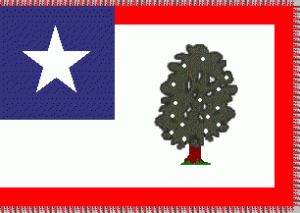 On 9 January 1861, the Convention of the People of Mississippi adopted an Ordinance of Secession. With the announcement of the Ordinance, a large blue flag bearing a single white star was raised over the capitol building in Jackson. One of the witnesses to this event, an Irish born actor named Harry Macarthy, was so inspired by the spectacle that he wrote a song entitled The Bonnie Blue Flag, which was destined to be the second most popular patriotic song in the Confederacy. If your computer has an audio system, the tune you are hearing is Macarthy’s The Bonnie Blue Flag.
On 9 January 1861, the Convention of the People of Mississippi adopted an Ordinance of Secession. With the announcement of the Ordinance, a large blue flag bearing a single white star was raised over the capitol building in Jackson. One of the witnesses to this event, an Irish born actor named Harry Macarthy, was so inspired by the spectacle that he wrote a song entitled The Bonnie Blue Flag, which was destined to be the second most popular patriotic song in the Confederacy. If your computer has an audio system, the tune you are hearing is Macarthy’s The Bonnie Blue Flag.
The first recorded use of a lone star flag dates to 1810. At that time the portion of Louisiana east of the Mississippi River, along with the southern portions of Mississippi and Alabama, made up the Spanish province of West Florida. This area had one been a part of French Louisiana. In 1763, after the French and Indian War, France ceded New Orleans and all of Louisiana west of the river to Spain. That portion of Louisiana east of the river was ceded to Great Britain, which named the region West Florida. West Florida was conquered by Spain during her campaigns as an American ally in the Revolutionary War. When France later re-acquired Louisiana from Spain, there was some dispute about whether or not the transaction included West Florida. Spain refused to relinquish control of the province, and the United States inherited the dispute when they purchased Louisiana from France in 1803.
The inhabitants of West Florida were in large part English speaking people on whom the authoritarian rule of Spain did not wear well. They were disappointed in the failure of the United States to annex the territory, and in 1804 an unsuccessful revolt was lead by the brothers Reuben, Nathan, and Sam Kemper. In the years following the Kemper Rebellion, the English speaking people of West Florida attempted to secure some degree of traditional English liberties within the framework of their Spanish government. This culminated in a convention of the people meeting in 1810 to press for some form of constitutional guarantees. Governor de Lassus pretended to cooperate with the convention while sending to the governor of East Florida for troops to put down this perceived threat to his authority.
Upon learning of the governor’s duplicity, the supporters of the convention turned to open rebellion. On Saturday, September 11, 1810, a troop of dragoons under the command of Major Isaac Johnson set out for the provincial capitol at Baton Rouge. At the head of the column rode a colour sergeant carrying a blue flag with a single, five-pointed white star. This flag had been made a few days before by Mrs. Melissa Johnson. Together with other republican forces under the command of Colonel Philemon Thomas, these men captured Baton Rouge without loss to themselves, imprisoned Governor de Lassus, and on September 23, 1810, raised their bonnie blue flag over the fort of Baton Rouge. Three days later, John Rhea, president of the West Florida convention, signed a Declaration of Independence, and the lone star flag became the emblem of a new republic.
The Republic of West Florida was short-lived. When Spanish rule was removed from the country with neither the use of American troops nor risk to itself, the government of the United States was interested in asserting its claim to West Florida. On October 27, 1810, President James Madison issued a proclamation declaring West Florida under the jurisdiction of the governor of the Louisiana Territory. On December 10, 1810, the flag of the United States replaced the Bonnie Blue flag over Baton Rouge, and the Republic of West Florida passed into history.
 The memory of the West Florida movement lived on in Southern tradition. Twenty-nine years later the Republic of Texas adopted a similar national flag, replacing the white star with a yellow star. Another twenty-two years after that, for a few weeks in 1861, the lone star flag of West Florida would rise again as the unofficial flag of the Republic of Mississippi; and Harry Macarthy’s song would spur it on into the romantic lore of the South. When the song was first played in New Orleans before a mixed audience of Texans and Louisianans, it was received with an outburst of approval that was nearly riotous.
The memory of the West Florida movement lived on in Southern tradition. Twenty-nine years later the Republic of Texas adopted a similar national flag, replacing the white star with a yellow star. Another twenty-two years after that, for a few weeks in 1861, the lone star flag of West Florida would rise again as the unofficial flag of the Republic of Mississippi; and Harry Macarthy’s song would spur it on into the romantic lore of the South. When the song was first played in New Orleans before a mixed audience of Texans and Louisianans, it was received with an outburst of approval that was nearly riotous.
 The flag’s existence was mostly a factor of Macarthy’s song. It was not much used as a secession flag, being far overshadowed by palmetto flags and by lone star flags in colours other than a white star on a blue field. It was never adopted by the Confederate government, although Mississippi did adopt an official flag on January 26, 1861 that incorporated it as a canton. But as a result of Macarthy’s song, the Bonnie Blue Flag spread across the Confederate nation and into the hearts of its people.
The flag’s existence was mostly a factor of Macarthy’s song. It was not much used as a secession flag, being far overshadowed by palmetto flags and by lone star flags in colours other than a white star on a blue field. It was never adopted by the Confederate government, although Mississippi did adopt an official flag on January 26, 1861 that incorporated it as a canton. But as a result of Macarthy’s song, the Bonnie Blue Flag spread across the Confederate nation and into the hearts of its people.
Devereaux D. Cannon, Jr.